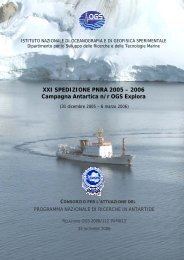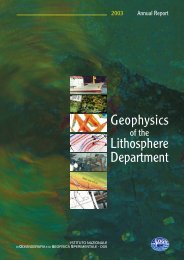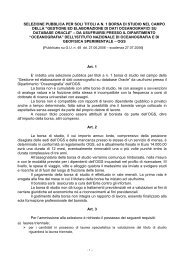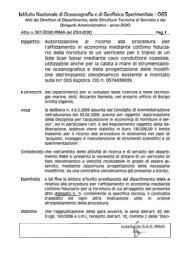Geophysical data acquisition - OGS
Geophysical data acquisition - OGS
Geophysical data acquisition - OGS
Create successful ePaper yourself
Turn your PDF publications into a flip-book with our unique Google optimized e-Paper software.
Physical properties of sediment cores<br />
from the Antarctic continental margins<br />
M. BUSETTI<br />
Antarctic paleoclimate and paleoenvironmental studies have a key role in the<br />
understanding of the global climate changing. Waxing and waning dynamic of the<br />
Antarctic ice coverage is the most important effect at high latitudes as response to<br />
climatic variations. As sediment deposited on the continental shelf and rise record<br />
the ice fluctuations, they are an essential task in the paleoclimate study. Analysing<br />
the acoustical and physical properties of sediment cores it is possible to investigate<br />
glacial and interglacial stages. P-wave velocity, bulk density and magnetic<br />
susceptibility are closely related to sediment composition and may reflect changes<br />
in grain-size distribution or in the ratio of terrigenous (quartz and clay) and<br />
biogenic components. Generally terrigenous sediment characterise glacial<br />
deposits, while biogenic material is present in the interglacial deposits.<br />
Acoustical and physical property logs of a marine piston core collected on the<br />
continental rise of the Antarctic margin. P-wave velocity and bulk density reflect<br />
the grain size distribution: the higher values in the upper part of the core are<br />
related to silt, and even greater to sand, the lower values in the deeper part<br />
of the core are related to the clay fraction. Ice rafted debris (black spots in the<br />
visual log) produce clear spikes in the magnetic susceptibility measurements.<br />
51






